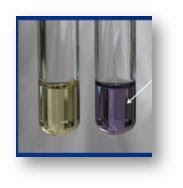Hippurate hydrolysis test can be used for presumptive identification of Gardnerella vaginalis, Campylobacter jejuni, Listeria monocytogenes and group B streptococci.
Principle of Hippurate hydrolysis test
Hippurate hydrolysis test is used to detect the ability of bacteria to hydrolyse hippurate into glycine and benzoic acid by action of hippuricase enzyme present in bacteria. Previously, it was tested using ferric chloride as indicator to detect benzoic acid which took 48 hours to produce result but now a rapid test (2 hours compared to 48 hours) is used in which an oxidizing agent ninhydrin is used as an indicator. Ninhydrin reacts with glycine to form a deep blue or purple color (Ruhemann’s purple).
Procedure /Method of Hippurate hydrolysis test
- Add 0.2ml (3-4 drops) of sterile distilled water to a test tube.
- Using a heavy inoculum (a full 10ul loop is adequate) from an 18-24 hour culture, make a heavy suspension of the organism to be tested.
- Using sterile forceps, place a rapid hippurate disk in the mixture.
- Cap and incubate the tube for two hours at 35-370C.
- After the two hour incubation period,add 0.2 ml (3-4 drops) of the ninhydrin reagent to the Hippurate and organism mixture.
- Reincubate at 35-37 oC. for 15-30 minutes. Observe the tubes at 10 minute intervals for the appearance of a deep blue color. The color change will usually appear in 10 to 15 minutes after the ninhydrin reagent has been added.
Expected results
Positive: Deep purple color
Negative: Colorless or slight yellow pink color
Quality Control:
Positive control: Streptococcus agalactiae ATCC 12386
Negative control: Streptococcus pyogenes ATCC 19615
Views – 17786
.jpg)
Leave a Comment